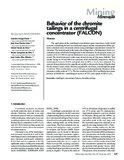| dc.creator | Freire, Leandro Araujo | |
| dc.creator | Leite, José Yvan Pereira | |
| dc.creator | Silva, Daniel Nunes da | |
| dc.creator | Silva, Bruno Gonçalves da | |
| dc.creator | Oliveira, José Carlos Silva | |
| dc.date.accessioned | 2020-12-04T12:42:15Z | |
| dc.date.available | 2020-12-04T12:42:15Z | |
| dc.date.issued | 2019-02-03 | |
| dc.identifier.citation | FREIRE, L. A.; LEITE, J. Y. P.; SILVA, D. N.; SILVA, B. G.; OLIVEIRA, J. C. S. Behavior of the chromite tailings in a centrifugal concentrator (FALCON). REM - International Engineering Journal, v. 72, n. 1, pp. 147-152, jan./mar. 2019. | pt_BR |
| dc.identifier.issn | 2448-167X | pt_BR |
| dc.identifier.uri | http://memoria.ifrn.edu.br/handle/1044/1884 | |
| dc.description.abstract | The application of the centrifugal concentration gains importance in the world scenario, considering the low environmental impact and the concentration of fine particles. Literature does not present articles using centrifugal concentration (Falcon) for chromite. The material used in the tests is the tailings from a Northeastern Brazil concentration plant, which was homogenized in the laboratory. In the process assays, the number of G (25-300 G) and the fluidization water pressure (20-100 kPa) were optimized. The initial tests used a wide range of particle size of 1 kg mass, with the "best results" being for 50 and 100 G at a pressure of 60 and 80 kPa, respectively, where a metallurgical recovery of 25% and grade close to 20% of Cr2O3 were obtained. The amount of mass showed to be a significant variable in the process, being 250 g the ideal for the material used, which obtained considerable recoveries, even though the grade is still low. These results led to a cut at 250 µm, considering that the liberation of the chromite is of the order of 77 %. The best result was with 150 G and fluidization water pressure of 60 kPa for a metallurgical recovery of 72% and a grade of 28% Cr2O3. | pt_BR |
| dc.language | eng | pt_BR |
| dc.publisher | Instituto Federal de Educação, Ciência e Tecnologia do Rio Grande do Norte | pt_BR |
| dc.relation.ispartof | REM - International Engineering Journal | pt_BR |
| dc.rights | Acesso Aberto | pt_BR |
| dc.subject | centrifugal concentrator | pt_BR |
| dc.subject | Falcon | pt_BR |
| dc.subject | chromite | pt_BR |
| dc.subject | tailings | pt_BR |
| dc.title | Behavior of the chromite tailings in a centrifugal concentrator (FALCON) | pt_BR |
| dc.type | Artigo de Periódico | pt_BR |
| dc.publisher.country | Brasil | pt_BR |
| dc.publisher.department | Natal - Central | pt_BR |
| dc.publisher.initials | IFRN | pt_BR |
| dc.subject.cnpq | Engenharia | pt_BR |
| dc.citation.volume | 72 | pt_BR |
| dc.citation.issue | 01 | pt_BR |
| dc.citation.spage | 147 | pt_BR |
| dc.citation.epage | 152 | pt_BR |
| dc.identifier.doi | http://dx.doi.org/10.1590/0370-44672018720016 | pt_BR |
| dc.description.resumo | The application of the centrifugal concentration gains importance in the world scenario, considering the low environmental impact and the concentration of fine particles. Literature does not present articles using centrifugal concentration (Falcon) for chromite. The material used in the tests is the tailings from a Northeastern Brazil concentration plant, which was homogenized in the laboratory. In the process assays, the number of G (25-300 G) and the fluidization water pressure (20-100 kPa) were optimized. The initial tests used a wide range of particle size of 1 kg mass, with the "best results" being for 50 and 100 G at a pressure of 60 and 80 kPa, respectively, where a metallurgical recovery of 25% and grade close to 20% of Cr2O3 were obtained. The amount of mass showed to be a significant variable in the process, being 250 g the ideal for the material used, which obtained considerable recoveries, even though the grade is still low. These results led to a cut at 250 µm, considering that the liberation of the chromite is of the order of 77 %. The best result was with 150 G and fluidization water pressure of 60 kPa for a metallurgical recovery of 72% and a grade of 28% Cr2O3. | pt_BR |




